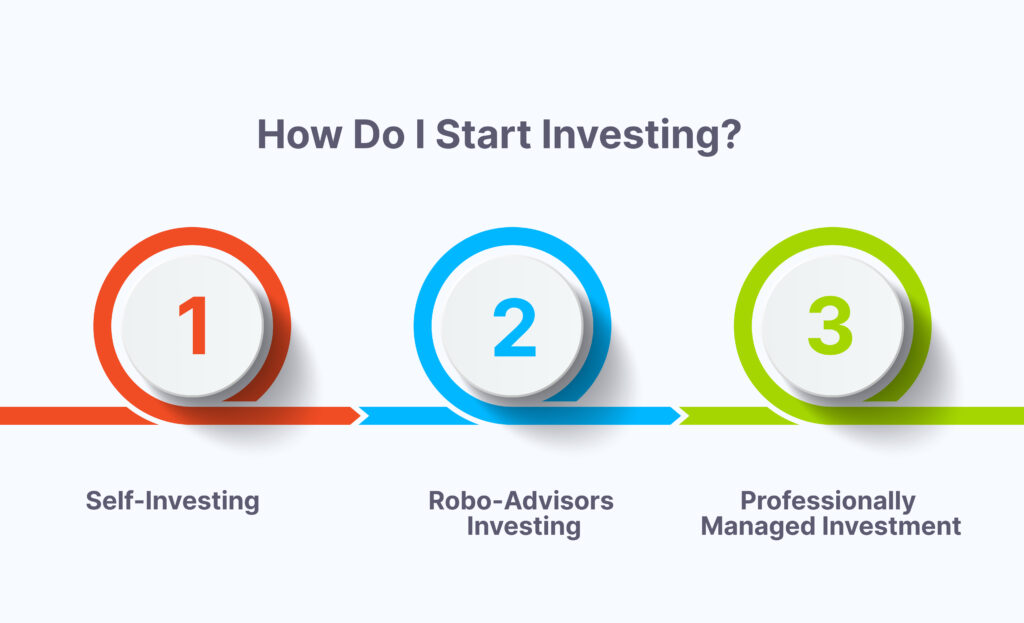What is investing?
In a broad term, investing is the process of making your money work for you. However, in this context you make your money work for you by allocating some of your money into assets or ventures. While with the expectation of having a return on investment meaning generating more than what you initially invested. With investing, your money is never idle, it allows it to grow and generate your income.
Therefore you can simply consider investment as the process of allocating money or resources to generate income, returns, and profits in the future. The primary goal of investment is to grow wealth, preserve capital and achieve certain financial objectives.
What to consider before investing?

Before investing, it’s important to consider some factors to make an informed decision that will align with your investment goal.
- Set a Financial Goal
Before investing, clearly define your main goal for investing, and when and how you intend to achieve it. Ask yourself what exactly you intend to achieve with your portfolio. This could be whether you are planning for retirement, intending to buy a house or you just generally want to build your wealth. Having a clear goal will help you understand the strategy to employ and how exactly to go about the investment.
2. Assess your Risk Tolerance
It’s important to consider how much risk you can tolerate due to market fluctuations and the value of your investments. While some investments may give higher returns, some tend to be riskier. Taking more money risk than you have ever taken may discourage you from the investment which may lead you to drop out of the portfolio before achieving the full-time frame you intend.
3. Decide on your Investment Timeframe
Your investment timeframe refers to the duration you plan to hold your investment before the need to access the funds. Your financial goals will determine the timeframe you will allocate to your investment.
- Short-term goals of (1-3)years: A short-term goal may include saving for a house, or a vacation. For this, your strategy could be considered a liquid investment with lower volatility.
- Mid-term goals of (3-10)years: A mid-term goal could be funding education, starting a business, home renovations or even career development. For a portfolio like this, you can incorporate a mix of stocks and bonds to achieve higher returns while still maintaining capital preservation.
- Long-term goals of 10 years and above: Long-term goals like a retirement plan usually offer more growth opportunities. With a longer timeframe, you may be able to take on more risks in your investment. You can consider a diverse portfolio, with a higher allocation of stocks which have strong returns over an extended period.
4. Learn about the Market / Seek Professional Advise
As an individual to starts investing or has an investment, it’s important to learn about the financial market, investments do’s and don’t and the economic indicators. Having this knowledge will help you in making the right decisions for your investment. However, for situations where you find to comprehend and make the right decisions, you can seek out professional advice to guide you through the process of the investment.
5. Research the Investment Options
Before you start investing, consider other potential options within your risk tolerance. To conduct thorough research, understand various investment performances, risks and potential returns of each investment option you intend to consider. While some investments could have potential more than others, you can consider diversification of your portfolio that way you do not miss out on a potential investment and your risk is balanced among your portfolios.
Types of Investments

There are various types of investments you can explore each with its risk-return profiles and the purpose they serve.
- Stocks
Buying a stock is like owning part of shares of a company. Investors buy shares of a company’s stock making you a stockholder of a company’s shares, and in return, you receive dividends and benefits from capital appreciation when the stock price increases.
2. Bond
A bond represents a form of debt security whereby investors lend money to an entity like a government, or corporation. Buying a bond, means you have a share of the entity’s debt in exchange for regular interest payments and the full value of the bond at the point of maturity. Bonds are also considered to be fixed-income securities.
3. Mutual Funds
This is a type of investment that combines money from various investors to invest in varied portfolios of stocks, bonds, or other investment portfolios. A mutual fund is usually managed by a professional portfolio manager who makes the decisions for the investors. For individuals who are just getting into investing, you can consider mutual funds as it allows investors to invest small amounts of money and it allows for diversification reducing the risk of any investment.
4. Real Estate Investment
Real estate investment involves purchasing physical properties such as residential or commercial real estate either to rent it out or live in it. In exchange for earning rental income or benefitting from property appreciation. Also, you can buy shares in a real estate investment trust which means you indirectly invest in real estate. Which will in turn provide income in the form of dividends.
5. Fixed Deposit Investment
This is a type of investment usually offered by banks or other financial institutions that allows individuals to deposit a sum of money for a fixed period at a pre-determined interest rate. Fixed deposits are considered to be low-risk investments and easy to venture into.
They can be a good start for new investors with low-risk tolerance as it is known for its stability without market influence and its fixed return on investment(ROI). To start your journey as an investor, you can explore Mintyn Bank fixed deposit, we offer the highest ROI compared to other banks. And be reassured to have a seamless experience as our investment managers will guide you at every step of the way.
You can venture into low-risk stable investments with
6. Commodities
Commodity investment is the buying and selling of physical goods to generate returns. Commodities are categorized as hard commodities and soft commodities; Hard commodities are natural resources like gold, and oil metals and soft commodities are coffee, corn or wheat. With commodities, investors can engage in physical trading by involving in the actual buying and selling of the product or participate in the commodity market by investing in commodity funds.
Benefit of Investment
Investing offers several benefits that can contribute to wealth-building or achieving your financial goals. However, there are other benefits you can derive from investing that can contribute to your financial well-being.
- Wealth Building: One of the main benefits you can derive from investing is the potential to accumulate your wealth. Using your money to buy various assets such as stocks, bonds or even mutual funds which appreciate over time, can help build your wealth.
- Achieving Financial Milestones: Investing helps individuals achieve their financial goals more easily. These financial goals may include buying a house, funding for education or saving for retirement. Having a portfolio, particularly for your goals can provide a structured approach to wealth accumulation.
- Income Generation: Investing in different assets can provide you with a steady flow of income. These incomes can be in various whether it’s a dividend, interest, or capital gain. This stream of income can provide financial stability and contribute to supporting a comfortable lifestyle.
- Diversification: The key benefit that comes with investment is that you can diversify where you put your money. Having a diversified portfolio means more dividends or interest and a balanced risk. That is while some investments can be risky, some are not. Which balances your risk tolerance and provides a safety net in any unforeseen situation.
- Tax Advantages: Having an investment is a good way to grow your wealth as it saves you by reducing your taxable income. Some investment options come with tax benefits. Like an individual savings account, it comes with a tax advantage which may offer you the opportunity of tax-deferred growth, and you can also qualify for preferential tax treatment with some other investment.
- Retirement Planning: Investing is an important part of retirement planning. Medium such as employer-sponsored retirement accounts, (401)K and individual retirement accounts (IRA) provide tax advantages, and help individuals build funds for their retirement years.
How Do I Start Investment?

To start investing, there are three main options to consider;
- Self-Investing:
To be an investor by do-it-yourself, you have to educate yourself on all the options available for you to explore. You research the market and equip yourself on how it works, their economic value, their volatility and the risk that comes with each of them.
By doing this you can confidently invest in any assets of your choice knowing your risk tolerance. However, if you find it impossible or difficult to dedicate such commitment to investment to reach the DIY stage, it might be best to get a professional investment manager.
- Robo-Advisors Investing
This is an automated algorithm-driven financial planning investment platform that provides investment information. This artificial intelligence gathers information about investors, their risk tolerance, financial goals and investment horizon to make suitable suggestions for diversified investment portfolios.
One of the main benefits of Robo-advisors apart from the suggestions they offer, it’s the cost-saving fees compared to traditional investment advisors. It also monitors the performance of each of your portfolios and rebalances it to align with the investor’s goals.
- Professionally Managed Investment
This is the practice of entrusting the management of an investment portfolio to a professional investment manager. This manager will make investment decisions on behalf of their client’s goals and risk as they are already equipped with the knowledge of investing.
They assess their client’s financial situations and create tailored plans. While you have to pay for their services and they can be more expensive than Robo Advisor, you can be reassured of the convenience and the right investment decisions they will make for you.








